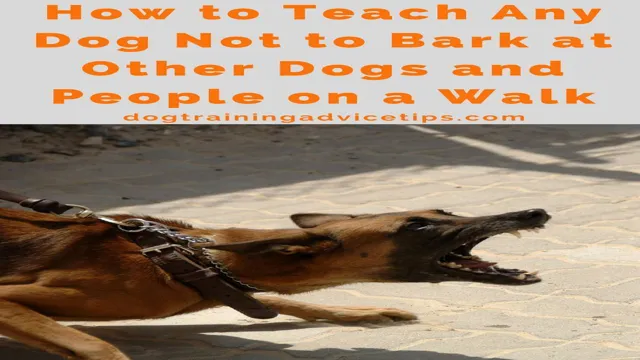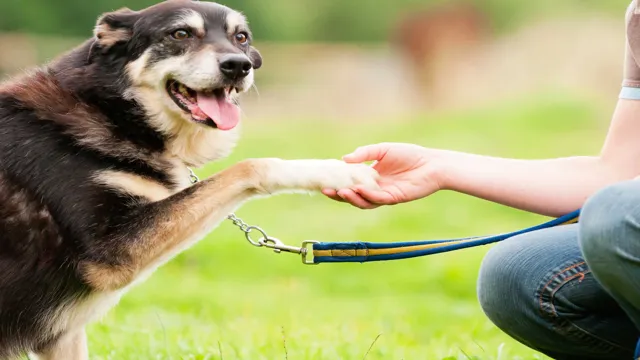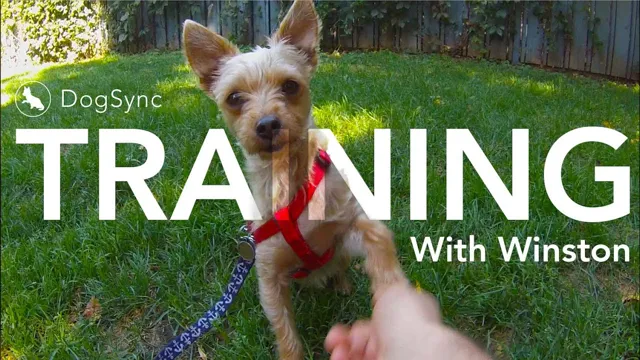Teaching Your Dog How to Be Calm Around Other Dogs: A Guide

Are you tired of constantly being embarrassed by your dog’s excessive barking when it sees other dogs? Teaching your dog not to bark at other dogs can be a difficult task, but it is not impossible! With patience, consistency, and the right techniques, you can effectively train your dog to stop barking at other dogs. In this blog, we’ll discuss some of the best practices to help you teach your dog not to bark at other dogs, so you can enjoy a peaceful and stress-free walk.
Understanding Why Dogs Bark
Dogs are social creatures and naturally bark when they see and hear other dogs. Barking can be seen as a way of communication between dogs. It can be used to express excitement, alertness, or even aggression. While it is natural for dogs to bark, it can become a nuisance when it becomes excessive. If you want to teach your dog not to bark at other dogs, the first step is to understand why your dog is barking.
Barking can be a symptom of anxiety or fear. If your dog barks when it sees other dogs, it may be feeling overwhelmed and is trying to alert you to potential danger. This type of barking may require additional training and patience to help your dog feel more relaxed around other dogs. Another reason your dog may be barking at other dogs is due to boredom or lack of exercise. If your dog is not getting enough physical activity, it may start to bark to express its energy.
This can be remedied by increasing your dog’s activity levels. Taking your dog for regular walks and engaging in interactive playtime can help to reduce excessive barking. It is also important to remember that dogs naturally bark to communicate with one another. If your dog is barking at another dog, it may be trying to send a message. If you notice your dog barking in a certain situation, try to identify the underlying cause.
Finally, it is important to provide your dog with positive reinforcement when it is not barking. Whenever you see your dog not barking at another dog, make sure to reward it with treats or verbal praise. This will help to reinforce the desired behavior and encourage your dog to continue not barking in the future. By understanding why your dog is barking, you can take the necessary steps to reduce excessive barking and help your dog feel more comfortable and relaxed. With patience and consistency, you can teach your dog not to bark at other dogs and enjoy a peaceful and stress-free relationship with your four
Identifying the Cause of the Barking
Do you have a dog that barks incessantly at other dogs? It can be a difficult problem to solve but with some patience and dedication, you can teach your pup not to bark at other dogs. First, it’s important to identify the cause of the barking. Is your dog barking because they are scared of other dogs or because they are excited? If it’s because they are scared, try to help them become more comfortable around other dogs by gradually introducing them to the situation. Start with a distance, and gradually get closer. If the barking is due to excitement, then try to teach your pup to focus on you when other dogs are around.
Praise them for good behavior and reward them with treats so that they learn that barking isn’t necessary. With patience and dedication, you can teach your pup to remain calm and collected around other dogs.

Recognizing Your Dog’s Signs of Stress
Training your dog not to bark at other dogs can be a challenge, but it’s essential for ensuring their safety and the peace of your neighborhood. Teaching your pup to remain calm and quiet in the presence of other dogs requires patience and consistency. Before you start, it’s important to recognize the signs of stress in your dog. Signs that your pup is feeling anxious or scared include cowering, panting, trembling, whining, and hiding. If you notice any of these signs, take a step back and have a break from the training.
It’s also a good idea to give your pup treats or praise when they’re around other dogs to reward them for not barking. With patience and a lot of practice, you can help your pup learn to stay calm and quiet around other dogs.
Establishing a Positive Environment for Training
Training your dog not to bark at other dogs is an essential part of becoming a responsible pet owner. While it may seem like a daunting task, there are several steps you can take to ensure you and your pup have a positive and successful training experience. The first step in training your dog not to bark at other dogs is to create a positive environment for your pup. This means that you should start by rewarding your pup for desired behaviors such as sitting and staying. This will create a positive association between being around other dogs and getting rewards.
The next step is to work on teaching your pup to focus on you while in the presence of other dogs. This can be done by teaching your pup to look at you when they see another dog. You can reward them for doing so and then slowly start adding distractions such as other dogs. It is also important to create a safe space for your pup. If your pup is feeling anxious or overwhelmed by other dogs, give them space to relax.
This could mean bringing your pup to a quiet area away from other dogs or allowing them to stay on a leash while they are in the presence of other dogs. Finally, it is important to not punish your dog for barking at other dogs. Punishment can be overwhelming for your pup and may make them feel even more anxious when they are around other dogs. Instead, focus on rewarding desired behaviors and teaching your pup to focus on you when in the presence of other dogs. By taking these steps, you can create a positive environment for training your pup not to bark at other dogs.
With patience and consistency, you can help your pup learn to be comfortable and relaxed when around other dogs.
Creating a Calm Space
It’s natural for dogs to bark when they encounter other dogs, but it can be a source of frustration for owners. If you’re looking to teach your pup not to bark at other dogs, the key is to create a calm space. Start by teaching your pup good behavior in low-stimulus areas, such as your home or garden. With consistent training and positive reinforcement, your pup will eventually understand that barking is not the way to go when they interact with other dogs. In addition to training, you can also try using calming scents and sounds to help your pup become more relaxed.
With the right approach, your pup will soon learn that other dogs don’t need to be barked at, and you can all enjoy a peaceful walk together.
Providing Proper Exercise
Teaching your dog not to bark at other dogs can be a difficult task, but it is an important part of being a responsible pet owner. The key to success is to provide your pup with proper exercise and stimulation. A tired pup is a good pup! Start by taking your dog for regular walks and playdates with other dogs. This will help them get used to being around other pups and boost their confidence. You should also look for activities that your pup enjoys and provide plenty of mental stimulation and interactive play.
With patience and consistency, you can help your pup learn to be respectful of other dogs and be a well-mannered pup.

Rewarding Good Behavior
Teaching your dog not to bark at other dogs can seem like an impossible task. However, with the right techniques and a lot of patience, it is possible to reward good behavior and train your pup to be more relaxed around other dogs. The key is to provide positive reinforcement when your dog exhibits the desired behavior, and to remain consistent in your training. Start by teaching basic commands such as “sit,” “stay,” and “come,” and then practice those commands in situations where your dog is likely to bark. When your pup is successful, reward him with a treat or a game.
Over time, your pup will learn that he will be rewarded for good behavior and will be less likely to bark at other dogs.
Training Techniques to Reduce Barking
Barking is a natural and instinctive behavior for dogs, but too much of it can be a nuisance. If your dog barks too often or at inappropriate times, it can be incredibly frustrating and disrupt your daily life. Fortunately, there are several effective training techniques you can use to help your dog learn not to bark at other dogs. The first step to reducing your dog’s barking is to identify the reasons why they are barking. Is it out of fear, excitement, or boredom? Once you understand what is triggering the barking, you can take steps to address the issue.
Next, you need to make sure your dog is getting plenty of exercise and mental stimulation. A tired dog is less likely to bark out of boredom or anxiety. Take your pup on regular walks, play fetch, and make sure to give them plenty of toys and puzzles to keep them entertained.
When your dog starts barking at another dog, it’s important to redirect their attention. Make sure to have plenty of treats handy to reward your dog for good behavior.Immediately after your dog stops barking, give them a treat and praise them for being quiet. This will help them associate being quiet with getting a reward. Finally, you can use a “quiet” command to stop your dog from barking. Whenever your dog starts barking, calmly say “quiet” and give them a treat if they obey. Over time, your pup will learn to associate the command with silence and should be able to stop barking on command.
With patience and commitment, you can help your dog learn not to bark at other dogs. Remember to stay consistent with your training and reward your pup for good behavior. With the right techniques, you can help your pup become a more well-behaved pup in no time.
Ignoring Unwanted Barking
Dogs are naturally social creatures, so it’s not uncommon for them to bark at other dogs they encounter. Unfortunately, this behavior can be disruptive and even dangerous in certain situations. If your pup is barking at other dogs, it’s important to take steps to teach them not to do it. The key is to stay calm and give your pooch some clear cues that will let them know that this behavior is unwanted and will not be tolerated. Start by teaching your pup basic commands such as “sit” and “stay,” as these commands can help to redirect their attention away from the other dog.
If your dog continues to bark, try redirecting their focus to a toy or treat. You should also reward them with praise when they do manage to stay quiet. Finally, if your pup still can’t seem to stop barking, it may be time to seek the help of a professional trainer who can provide more tailored advice and guidance. With patience and dedication, you can help your pup learn to ignore other dogs and enjoy a peaceful walk with you.
Using Positive Reinforcement
Want to know how to teach your dog not to bark at other dogs? Positive reinforcement is one of the most effective ways to ensure your pup learns proper behavior. By providing your pup with rewards like treats, toys, and verbal praise, you can help them learn to associate good behavior with rewards. When your pup sees another dog, have them sit and remain calm. When they stay quiet, reward them with a treat or verbal praise. Eventually, your pup will understand that not barking is rewarded and will be more likely to stay quiet when they see other dogs.
Conclusion
So there you have it, a few simple tips and tricks for teaching your dog not to bark at other dogs. With patience, consistency and a bit of creativity, you can help your pup learn the ‘ruff’ rules of doggy etiquette and keep the peace in your home and beyond.”
FAQs
How can I teach my dog not to bark at other dogs?
To teach your dog not to bark at other dogs, start by socializing your dog with other dogs in a controlled environment. Speak to your dog in a calm and consistent tone, and reward them with treats when they remain quiet and calm. You can also use a sound-based training tool, such as a whistle, to distract your dog and refocus their attention.




